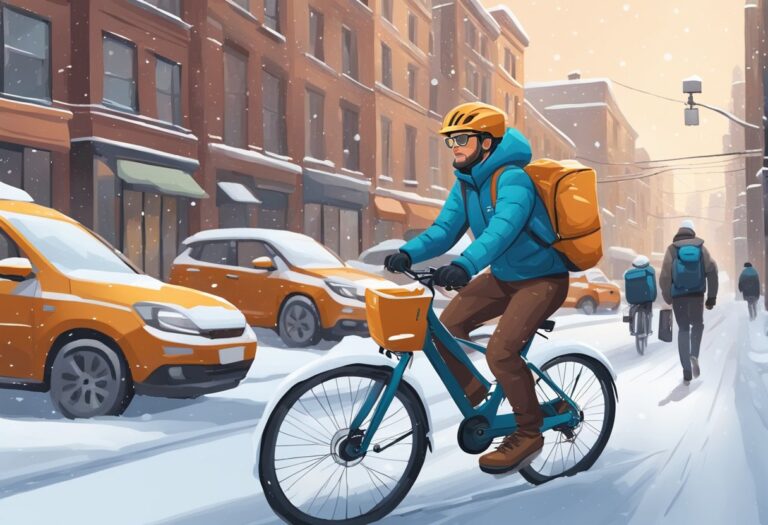Safe E-Bike Commuting: Essential Tips for Navigating Snowy Streets
E-bike riders often face the challenge of maintaining stability and safety while navigating through snowy streets during winter.
The combination of cold temperatures, icy pathways, and reduced visibility can make riding an electric bike more demanding.
However, with the right equipment and approach, electric bikes can be a reliable mode of transportation, even in snow.
Understanding the mechanics of your e-bike, the importance of proper gear, and smart riding techniques can significantly improve your winter riding experience.

Adapting to winter conditions means considering factors like battery performance in the cold, tire traction on slippery surfaces, and the need for increased visibility.
For electric bikes, the onset of winter requires a shift in maintenance focus, with particular attention to the battery, which may deplete faster in cold weather.
Riders must also prioritize their safety by modifying their riding habits, as snow-covered roads demand cautious handling and slower speeds to avoid accidents.
For those determined to continue riding through winter, electric bikes with fat tires are often recommended, as they provide better grip and stability on snowy terrain.
Visibility becomes paramount, with front and rear lights and reflective clothing helping e-bike riders remain visible to motorists and pedestrians.
By employing these strategies, riders can enhance their safety and continue to enjoy the benefits of electric biking, regardless of icy weather conditions.
Table of Contents
Understanding Electric Bikes in Winter
With the advent of winter, electric bike (e-bike) riders need to be aware of the specific challenges posed by snowy conditions and cold temperatures.
E-bikes require particular care and consideration during winter months to maintain safety, battery performance, and overall enjoyment of riding.
Winter Challenges for E-Bikes
Snow and ice introduce obstacles to the e-bike’s stability and maneuverability.
Battery performance can significantly decrease in cold temperatures, reducing power and range. Snow buildup can affect the bike’s components such as brakes and chains, increasing maintenance needs.
E-Bike Features for Snowy Conditions
Fat tires and studded tires offer better traction on slippery surfaces. Waterproof components are essential to protect the electric system from moisture.
E-bikes with mid-drive motors are better at handling hills and slick terrain compared to those with hub motors due to their improved torque and weight distribution.
Maintaining Battery Efficiency
To maximize battery life, keep the battery insulated and avoid charging it in freezing conditions. It’s advisable to store the battery indoors when temperatures plummet.
Riding in winter requires more frequent battery checks to ensure power is sustained during use.
Choosing the Right Electric Bike for Winter
Selecting an e-bike designed for winter use means prioritizing features like robust motors, durable frames, and fat tires for stability in the snow. Electric bicycle manufacturers may offer models specifically built for cold-weather riding.
The Importance of Regular E-Bike Inspections
Regular inspections are crucial for safety and maintenance in winter conditions. Pay close attention to tire pressure, chains, and brakes to ensure the e-bike is in top condition.
Routine checks can prevent accidents due to component failure under stress from the cold and snow.
E-Bike Winter Checklist
| Component | Inspection Focus |
|---|---|
| Battery | Charge level, insulation |
| Tires | Air pressure, tread condition |
| Chains and Brakes | Lubrication, responsiveness |
| Frame | Structural integrity, rust, cracks |
Preparation and Gear
Effective winter e-biking depends on thorough preparation and the right gear.
Riders should prioritize warmth, visibility, and bike performance to ensure a safe and pleasant journey.
Selecting Appropriate Winter Clothing
Proper layering is crucial for winter riding. Riders should start with a base layer that wicks moisture away from the body, add an insulating layer to retain heat, and finish with a windproof and waterproof outer layer.
Essential items include waterproof boots, wool socks, thermal gloves, and a helmet with face protection like goggles or a balaclava. Reflective clothing is also important to enhance visibility during low-light conditions.
Equipping Your E-Bike for Winter
To maintain control on snowy and icy roads, winter tires with deeper treads or studs are recommended. Fenders help shield riders from slush, and brake pads designed for wet conditions improve stopping power.
Adequate lighting is essential, both for seeing and being seen. Applying lubricant made for low temperatures can protect moving parts from freezing.
Pre-Ride Safety Checks and Adjustments
Before setting out, a safety check is imperative. This includes verifying tire pressure, brake functionality, and the effectiveness of the lighting system.
Braking distance increases on slippery surfaces, so it’s essential to test brakes and adjust one’s riding style accordingly.
Checking that batteries are fully charged is especially important in cold weather, as the cold can reduce their efficiency.
Emergency Kit and Extra Supplies
An emergency kit can be a lifesaver on winter rides. This should include tools for basic repairs, an extra battery if possible, and a portable bike pump.
Hand protection like pogies or bar mitts can provide additional warmth on long commutes. Also, consider carrying extra layers, such as a warm hat or an extra pair of gloves for prolonged exposure to the elements.
Storage and Accessibility
For commuters or those on longer rides, having accessible storage for extra supplies is important. Storage options such as waterproof panniers or bags can keep additional clothing and emergency items dry and within reach.
Commuting by e-bike in winter also means being prepared for changing conditions, so ensure that storage solutions are easy to use with cold fingers or when wearing gloves.
Riding Techniques in Snow
When operating an e-bike in snowy conditions, riders must adapt their techniques to maintain safety and traction. The right strategies can enhance both your control and enjoyment while navigating through challenging winter landscapes.
Navigating Through Snow and Ice
Riding an e-bike on snow-covered roads demands a vigilant approach to sustain good traction. Low gears are favorable as they provide increased torque, helping them maneuver with more stability.
Dual-purpose tires or those with a wide surface area and deep grooves improve grip on unstable surfaces.
For additional safety, reducing tire pressure can enhance the contact patch with the ground, resulting in better traction.
Brake Usage and Control
Braking technique is crucial for maintaining control. Always apply the brakes gently to prevent locking up the wheels, which can lead to skidding. Using pulse braking — a method of intermittent application and release — helps maintain brake performance and prevents overheating the brake pads.
Furthermore, e-bike riders should start slowing down earlier than usual to account for the longer stopping distances required on snowy streets.
Effectively Using Gears and Power
Strategic use of gears and power settings can make a significant difference in snowy conditions.
Employ a low gear to navigate slippery streets, which allows for controlled acceleration and helps in maintaining stability.
The throttle should be used sparingly to avoid sudden spikes in power that can disrupt traction. Consistency is key; a smooth, steady power delivery helps keep the bike stable.
Tips for Safe Turning and Stopping
Turns and stops must be approached with caution when riding on snow. Here are some concise tips for safe maneuvering:
- Turning: Slow down before the turn, lean gently into the curve, and avoid sharp movements.
- Stopping: Plan ahead, begin decelerating early, and apply brakes progressively.
Remember, each adjustment in riding technique contributes significantly to overall safety on snowy streets.
Post-Ride Care and Maintenance
Proper post-ride maintenance is crucial for e-bike longevity, especially after navigating snowy streets, which may introduce salt and dirt to components.
To ensure the bike’s performance and safety, riders should prioritize cleaning and protecting their e-bikes from corrosive elements.
Cleaning Procedures to Combat Salt and Dirt
- Materials Needed:
- Soft-bristled brush
- Biodegradable soap
- Lukewarm water
- Clean cloths or sponges
- Bike-specific lubricant
- Step by Step:
- Prep Your Bike: Brush off loose dirt and salt from the frame, tires, and components.
- Dilute Soap: Mix biodegradable soap with lukewarm water in a bucket.
- Clean Frame: Using a sponge, gently clean the frame, paying extra attention to areas where salt and dirt accumulate.
- Rinse: Rinse the soap off with lukewarm water, minimizing water exposure to electrical parts.
- Dry: Dry the e-bike thoroughly with clean cloths to prevent rust on metal parts.
- Drivetrain Maintenance: Clean the chain with a rag, removing debris before applying lubricant.
- Important Tips:
- Avoid High-Pressure Water: This can force water into bearings and electrical systems, leading to corrosion.
- Check for Wear: Inspect moving parts for signs of wear or damage caused by abrasive dirt or salt.
- Lubrication: Apply bike lubricant to the chain and any moving parts to ensure they remain protected from corrosion and operate smoothly.
After riding on snowy streets, diligent care and attention should be given to an e-bike’s maintenance. A consistent cleaning regimen helps combat rust and corrosion caused by salt and slush, thus extending the life and functionality of the bike.
Safeguarding Your E-Bike Against the Cold

With winter’s chill comes the responsibility to take additional steps to ensure the longevity and functionality of your electric bicycle.
When temperatures fall, e-bike owners should focus on meticulous maintenance and correct storage to prevent damage from cold weather.
Proper E-Bike Storage Solutions
Indoor Storage: Ideal for protecting battery health.
- Temperature Controlled: Store at above freezing temperatures.
- Dry Environment: Reduces risk of corrosion.
Outdoor Options:
- Insulated Covers: A minimum requirement to shield from snow and ice.
- Ventilated Space: Prevents condensation build-up.
Long-Term Maintenance for Winter Durability
- Routinely Clean and Dry: Post-ride, remove slush and grit to prevent corrosion.
- Regular Lubrication: Essential for chain and moving components.
| Winter Maintenance Checklist |
|---|
| Component |
| Chain lubrication |
| Battery check |
| Brake inspection |
| Tire pressure adjustments |
Managing Electrical Connections
- Regular Inspections: Ensure all connections are secure and moisture-free.
- Use Dielectric Grease: Prevents corrosion on connectors.
Protection Strategies:
- Waterproofing: Apply waterproof sprays to exposed connections.
- Silicone Seals: An extra barrier at junction points.
Protective Measures for E-Bike Components
- Comprehensive Cleaning: Key in avoiding rust and maintaining performance.
- Installation of Fenders: Prevents mud and debris from reaching sensitive parts.
Component Care:
| Component | Maintenance Tips |
|---|---|
| Battery | Store indoors. |
| Chain | Clean and lubricate often. |
| Fenders | Check for secure attachment. |
It is essential for e-bike riders to prepare and protect their bikes from winter’s harsh conditions.
While proper storage can keep electrical systems and batteries safe from extreme temperatures, routine maintenance including thorough cleaning and consistent lubrication will protect the bike’s moving components from wear and corrosion.
Equally important is the regular check-up of electrical connections to ensure they remain dry and secure.
By taking these proactive steps, e-bike enthusiasts can ensure that their ride remains safe and reliable throughout the colder months.
Handling Emergency Situations

E-bike riders navigating snowy streets must be prepared to handle emergencies efficiently.
Knowing common hazards, ensuring visibility, handling quick repairs, and recognizing when not to ride are critical to rider safety.
Identifying Common Winter Riding Hazards
Winter conditions bring a variety of hazards such as slippery roads, obscured potholes, and black ice. Riders should be attentive to weather forecasts and stay aware of snowy conditions, as these can change rapidly and influence the safety of trails and roads.
Being Visible to Others
In winter’s limited visibility, it’s vital to use lighting and wear reflective clothing to be seen by drivers and pedestrians.
Equip your e-bike with bright front and rear lights and wear clothing with built-in reflectors to enhance safety during commuting or short rides.
| Visibility Components | Description |
|---|---|
| Front & Rear Lights | Essential for being seen and seeing the path ahead. |
| Reflective Clothing | Increases your chances of being spotted by others. |
Emergencies and Quick Fixes on the Go
Carry a basic set of tools and spare brake pads to handle minor repairs.
In case of an unexpected dismount or if the e-bike malfunctions, knowing how to perform a quick fix can be the difference between a prolonged exposure to cold and a safe arrival at your destination.
When to Avoid Riding and Alternative Options
Sometimes, it’s safest to avoid riding altogether.
Severe weather conditions with heavy snow, ice, or below-freezing temperatures might warrant seeking alternative commuting options, such as public transportation or ridesharing, to ensure your safety.
Endnote: Embracing Winter E-Bike Riding

Electric bike enthusiasts often find that winter brings a unique set of challenges to their cycling routine. It is not merely about navigating through snow but also maintaining safety and enjoyment in colder climates.
Riders should equip themselves with the necessary knowledge and gear to ensure that their winter e-bike experience is rewarding.
Safety First
Safety is paramount when riding in winter conditions.
Ensuring that your e-bike has appropriate fat tires to navigate through snow can increase stability, greatly enhancing safety.
Moreover, riding at lower tire pressures can help the e-bike to ‘float’ on the snow, offering better traction.
Motivation Through Preparation
Effective winter e-bike riding begins with the right motivation, which stems from proper preparation. Dressing in layers can help regulate body temperature, while waterproof gear can keep one dry. Lights and reflectors are critical, as visibility is often compromised during winter months.
Building Confidence and Enjoyment
Confidence in winter cycling grows with experience. Starting out with short rides to acclimate to the conditions can lead to longer ventures as one becomes more comfortable. It’s not only a matter of pride in braving the elements but also finding enjoyment in winter e-bike adventures which can be exhilarating and refreshing.
In conclusion, embracing winter e-bike riding requires an informed approach. With a focus on safety, preparation, and the right attitude, cyclists can transform the chilly challenge of winter into an enjoyable and confidence-boosting part of their riding routine.




Leave a comment